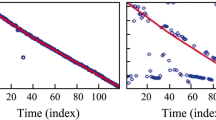Abstract
In order to solve the problem of depth classification of the underwater target in a very low frequency acoustic field, the active component of cross spectra of particle pressure and horizontal velocity (ACCSPPHV) is adopted to distinguish the surface vessel and the underwater target. According to the effective depth of a Pekeris waveguide, the placing depth forecasting equations of passive vertical double vector hydrophones are proposed. Numerical examples show that when the sum of depths of two hydrophones is the effective depth, the sign distribution of ACCSPPHV has nothing to do with horizontal distance; in addition, the sum of the first critical surface and the second critical surface is equal to the effective depth. By setting the first critical surface less than the difference between the effective water depth and the actual water depth, that is, the second critical surface is greater than the actual depth, the three positive and negative regions of the whole ocean volume are equivalent to two positive and negative regions and therefore the depth classification of the underwater target is obtained. Besides, when the 20 m water depth is taken as the first critical surface in the simulation of underwater targets (40 Hz, 50 Hz, and 60 Hz respectively), the effectiveness of the algorithm and the correctness of relevant conclusions are verified, and the analysis of the corresponding forecasting performance is conducted.
Similar content being viewed by others
References
Baggenstoss, P. M., 2011. An algorithm for the localization of multiple interfering sperm whales using multi-sensor time difference of arrival. Journal of Acoustical Society of America, 130(1): 102–112.
Brekhovskikh, L. M., and Lysanov, Y. P., 2003. Fundamentals of Ocean Acoustics. Third edition. AIP Press, America, 51.
Buchingham, M. J., and Giddens, E. M., 2006. On the acoustic field in a Pekeris waveguide with attenuation in the bottom half-space. Journal of Acoustical Society of America, 119(1): 123–142.
Dubreuil, M., Delrot, P., and Leonard, I., 2013. Exploring underwater target detection by imaging polarimetry and correlation techniques. Applied Optics, 52(5): 997–1005.
Diamant, R., Tan, H. P., and Lampe, L., 2014. LOS and NLOS classification for underwater acoustic localization. IEEE Transactions on Mobile Computing, 13(2): 311–323.
Dosso, S. E., and Wilmut, M. J., 2011. Bayesian multiple-source localization in an uncertain ocean environment. Journal of Acoustical Society of America, 129(6): 3577–3589.
Forero, P. A., 2014. Broadband underwater source localization via multitask learning. IEEE Information Sciences and Systems Conference. Princeton, New Jersey, 1–6.
Gerstein, E. R., and Gerstein, L., 2014. Manatee hearing and sound localization can help navigate noisy shallow waters and cocktail events, no Lombard’s needed. Journal of Acoustical Society of America, 135 (4): 2172.
Hui, J. Y., Sun, G. C., and Zhao, A. B., 2008. Normal mode acoustic intensity flux in Pekeris waveguide and its cross spectra signal processing. Acta Acustica, 33(4): 300–304 (in Chinese with English abstract).
Josso, N. F., Ioana, C., Mars, J. I., and Gervaise, C., 2010. Source motion detection, estimation, and compensation for underwater acoustics inversion by wideband ambiguity lag-Doppler filtering. Journal of Acoustical Society of America, 128(6): 3416–3425.
Liu, B. S., 2010. Underwater Acoustic Principle. Second edition. Harbin Engineering University Press, Harbin, 75 (in Chinese).
Michalopoulou, Z. H., Yardim, C., and Gerstoft, P., 2011. Particle filtering for passive fathometer tracking. JASA Express Letters, 1–7.
Wiggins, S. M., McDonald, M. A., and Hildebrand, J. A., 2012. Beaked whale and dolphin tracking using a multichannel autonomous acoustic recorder. Journal of Acoustical Society of America, 131(1): 156–163.
Yu, Y., Hui, J. Y., and Zhao, A. B., 2008. Complex acoustic intensity and application of normal modes in Pekeris waveguide. Acta Physic Sinica, 57(9): 5742–5748 (in Chinese).
Yu, Y., Hui, J. Y., and Chen, Y., 2009. Research on target depth sorting of shallow and low-frequency acoustic field. Acta Physic Sinica, 58(9): 6335–6343 (in Chinese).
Author information
Authors and Affiliations
Corresponding author
Rights and permissions
About this article
Cite this article
Yang, G., Yin, J., Yu, Y. et al. Depth classification of underwater targets based on complex acoustic intensity of normal modes. J. Ocean Univ. China 15, 241–246 (2016). https://doi.org/10.1007/s11802-016-2674-9
Received:
Revised:
Accepted:
Published:
Issue Date:
DOI: https://doi.org/10.1007/s11802-016-2674-9




